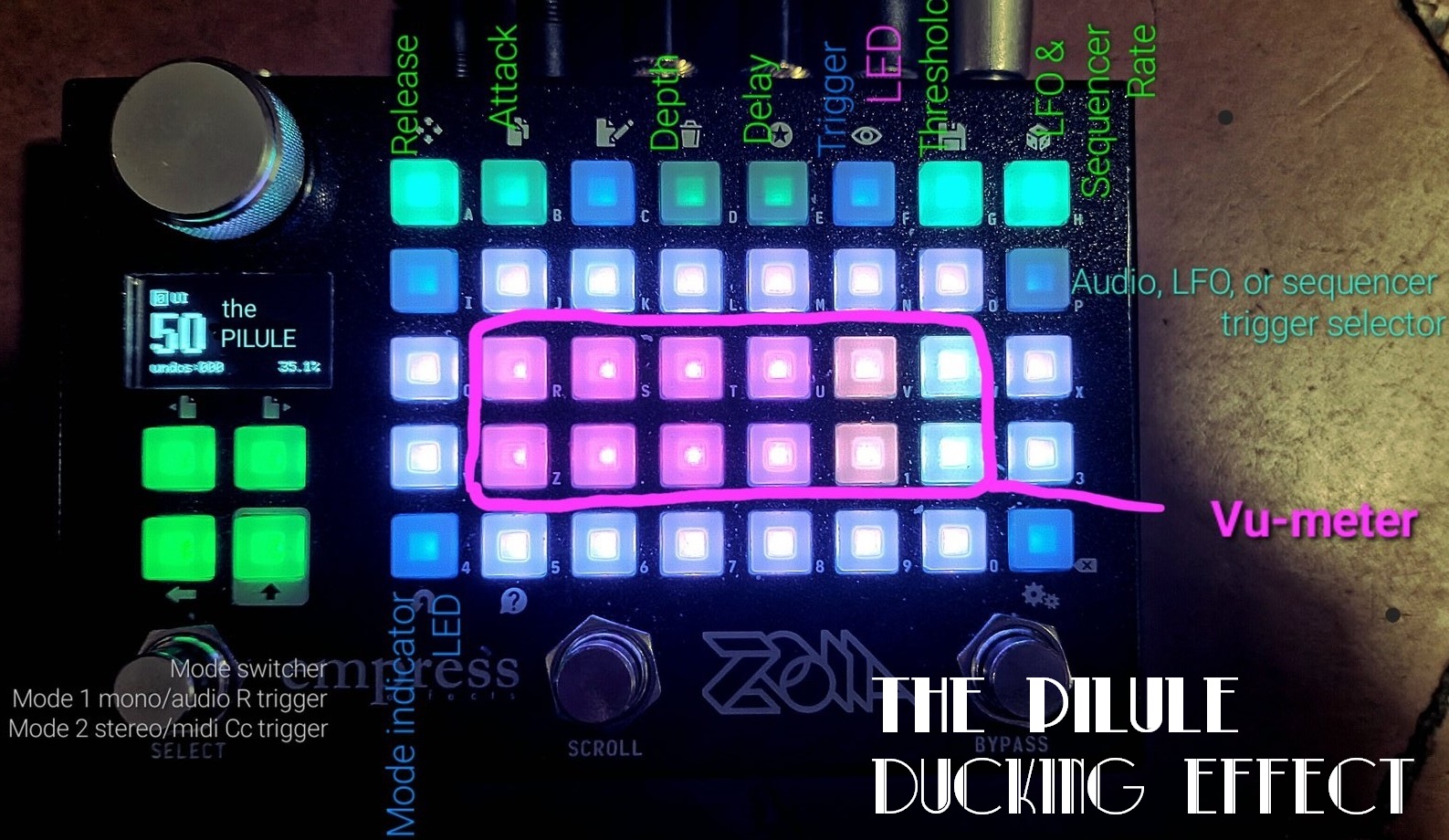the PILULE (v1.0)
This patch is inspired by the side-chained compression pedal named ’’the PILL’’, designed specifically for intense ducking effect that can border on the tremollo side of things with a fast trigger input.
It is, at the most basic level, an adjustable attack-decay enveloppe (delay-attack-decay to be precise), cubed in a multiplyer, in order to give it a curved / more ’’analog’’ / smoother shape, then also multiplied by a separate value controling ducking depth. It is then inverted to operate in the negative CV realm and finaly used to modulate directly the gain parameter of the audio output module.
the PILULE can work in 2 different modes :
– Mode 1 : Mono / Audio-triggered
The audio input is the Left input (which goes out to Left & Right ouputs).
The trigger input is audio signal coming from the Right input. Right audio signal doesn’t go through to the pedal output, it is only used as a trigger for the ducking effect.
In mode 1, if nothing is plugged as trigger in the Right audio jack, ZOIA automatically duplicate Left input in the Right channel, hence the ducking effect is triggered according to the player’s dynamic as a ‘‘standard’’ compressor.
– Mode 2 : Stereo / Midi CC-triggered
The audio path is stereo,.
The trigger input is a midi CC input (Channel 1 & Controller 3 by default, but of course map it as you like). Use any external midi controller/sequencer/what-you-like to trigger and sync the effect with other instruments as you wish !
The default mode when loading the patch is mode 1. Left stompswitch can be used to alternate between both modes. The lower-left corner blue pad of the UI page serves as a mode indicator LED :
Dimmed blue → Mode 1
Shiny blue → Mode 2
– Additional trigger options : LFO & Sequencer
The ducking effect can also be triggered by an LFO or by a sequencer that can be activated in either mode 1 or 2. If engaged, they override the audio or midi trigger
The UI-button just below the « LFO n Seq rate » knob (« p » key) can be used to switch between trigger types :
-Aqua → audio R trigger in mode 1 or Midi trigger in mode 2
-Sky → LFO trigger
-Blue → Sequencer trigger, the sequencer ryhtm can be programed on page 1 : « Sequencer »
Audio R or Midi is the trigger source selected by default when loading the patch.
User interface description (page 0 : « UI »)
The UI page retakes the appearance of the PILL pedal. It is comprised of :
– 3 groups of 2 ’’knobs’’ on the top row (surf color). See details below.
– A trigger input LED indicator (between 2d and 3rd knob group, on the « f » key) :
Flashes in purple when a ducking is triggered, whatever the selected trigger source.
In mode 1, it is very usefull in fine tuning the triggers from audio R source using the threshold knob
– A pill shaped decor, also serving as a Vu-meter of the ducking depth and enveloppe dynamic.
The « knobs » :
For each of the 3 groups of knobs, the left knob covers the same function as the PILL pedal’s corresponding knobs, and the right one adds an additional function compared to the original pedal.
Those 3 groups of knobs are, in order :
– Release (R, on the PILL) & Attack.
They control the corresponding enveloppe parameters.
Release time is constrained between 9.33ms and 8.2s. If your release time is longer than the time between 2 triggers, the volume will duck again before it could reach its normal volume again. But ducking’s depths won’t add up.
Attack time is constrained between 9.33ms and 500ms
– Depth (D, on the PILL) & Delay.
They control respectively the depth of the ducking effect (can go all the way from -0dB to complete silence), and the delay time between the trigger onset detection and the actual start of the volume ducking applied to the audio path (constained between 1.33ms and 200ms)
– Threshold (T, on the PILL) & LFO n Seq rate.
In mode 1, Threshold is controlling the trigger onset detector sensibility and helps a lot fine tuning what sound the pedal has to actually interpret as a trigger by allowing to control which transient strenght is detected or not. The falshing LED is here to help selecting those triggering transient. This knob has no use in mode 2 or with the LFO or the Sequencer engaged.
LFO n Seq rate is pretty self-explanatory : set LFO rate (constrained between 0Hz and 5Hz) or sequencer rate (constrained between 2Hz and 40Hz). The same setting value input is used in both case, so changing the rate for one will also change it for the other.
The Vu-meter :
It gives a visual cue of the effect settings and is really useful for better visualisation of the dialed-in depth and enveloppe dynamics.
It responds logarithmically to the volume decrease strength : It is very sensitive to very small ducking depth (on the white & peach side) and much less sensitive to big ducking depth (on the pink side), so that it is useful in the whole range of depth settings.
I won’t enter in more details about the inner working of the patch, which is not very interesting and rather straightforward, but you can find the complete patch diagram in SVG file in the patch zip folder (it’s vectorized for easy zoom in & out).
I’ll try to also link to it in a comment bellow.
CPU used : ~31 %
Built under ZOIA firmware 3.0



Here is an overiew of the complete diagram
(from far away, sorry, can’t upload an SVG file. If you want the zoomable SVG, it is available in the patch download folder)
Attachment the_PILULE_diagram-661ac5d801dfd.png